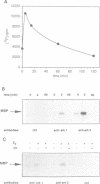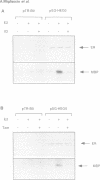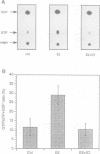Abstract
The mechanism by which estradiol acts on cell multiplication is still unclear. Under conditions of estradiol-dependent growth, estradiol treatment of human mammary cancer MCF-7 cells triggers rapid and transient activation of the mitogen-activated (MAP) kinases, erk-1 and erk-2, increases the active form of p21ras, tyrosine phosphorylation of Shc and p190 protein and induces association of p190 to p21ras-GAP. Both Shc and p190 are substrates of activated src and once phosphorylated, they interact with other proteins and upregulate p21ras. Estradiol activates the tyrosine kinase/p21ras/MAP-kinase pathway in MCF-7 cells with kinetics which are similar to those of peptide mitogens. It is only after introduction of the human wild-type 67 kDa estradiol receptor cDNA that Cos cells become estradiol-responsive in terms of erk-2 activity. This finding, together with the inhibition by the pure anti-estrogen ICI 182 780 of the stimulatory effect of estradiol on each step of the pathway in MCF-7 cells proves that the classic estradiol receptor is responsible for the transduction pathway activation. Transfection experiments of Cos cells with the estradiol receptor cDNA and in vitro experiments with c-src show that the estradiol receptor activates c-src and this activation requires occupancy of the receptor by hormone. Our experiments suggest that c-src is an initial and integral part of the signaling events mediated by the estradiol receptor.
Full text
PDF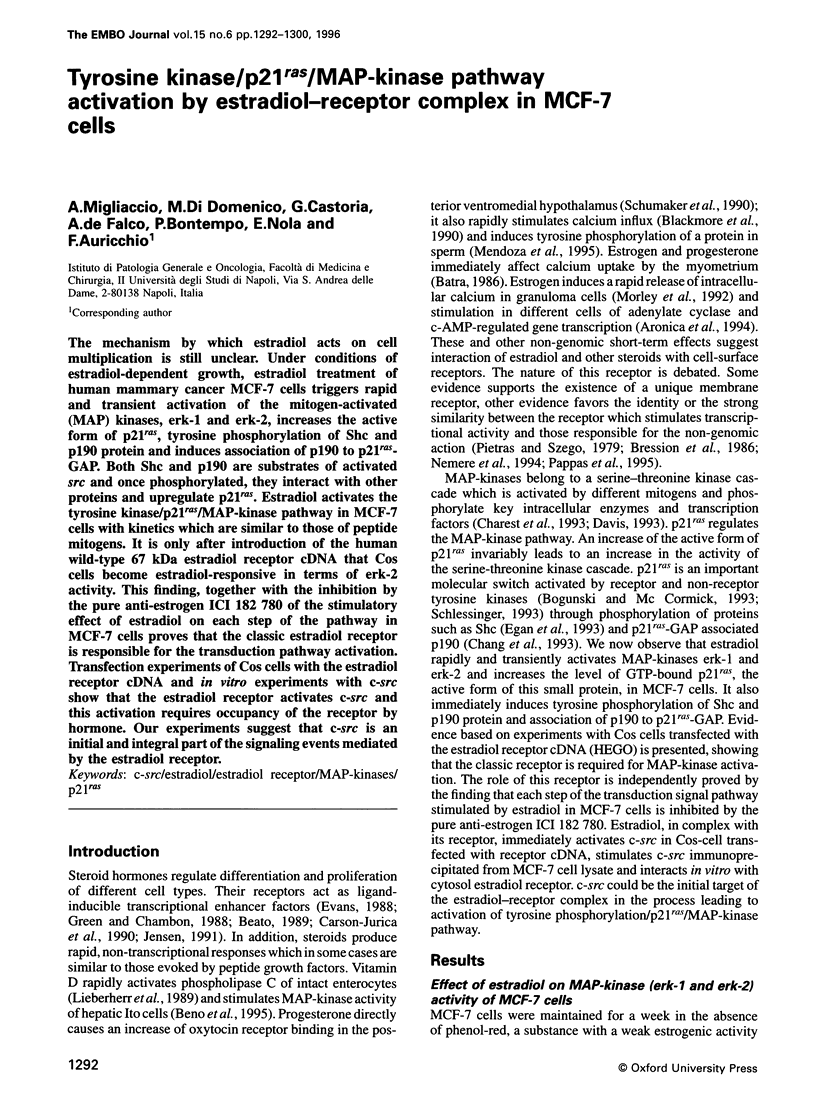
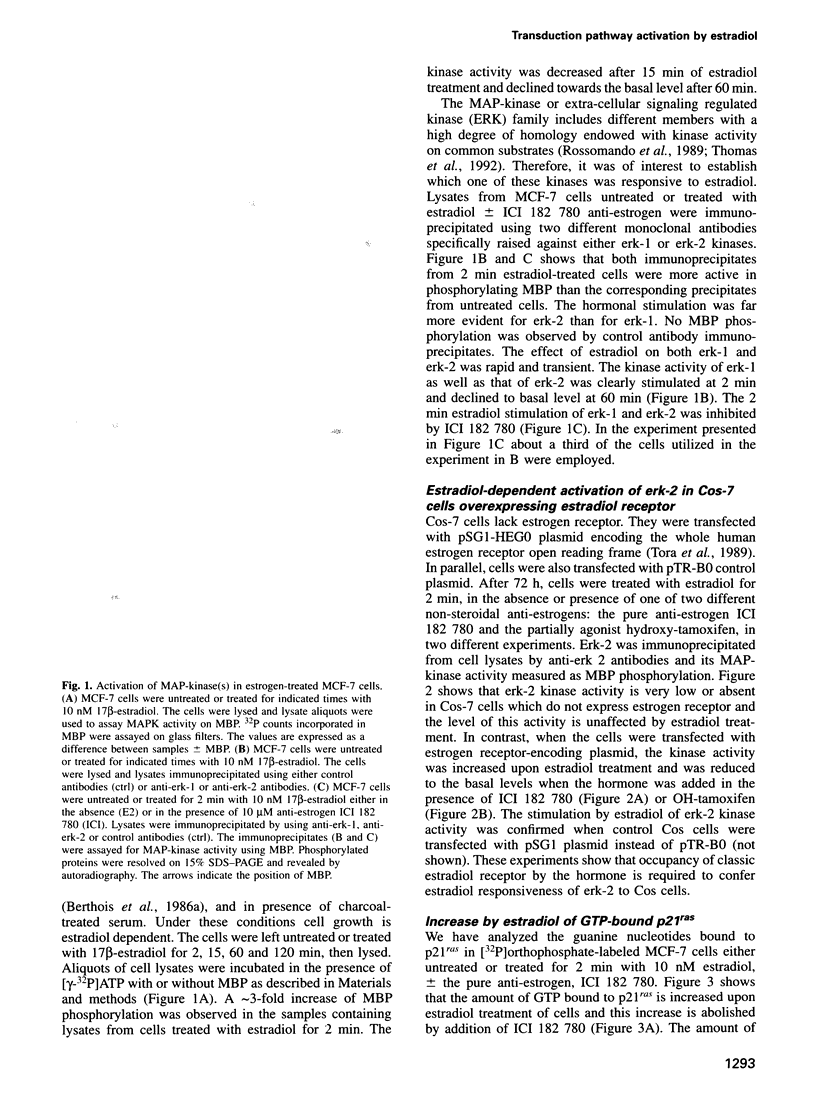
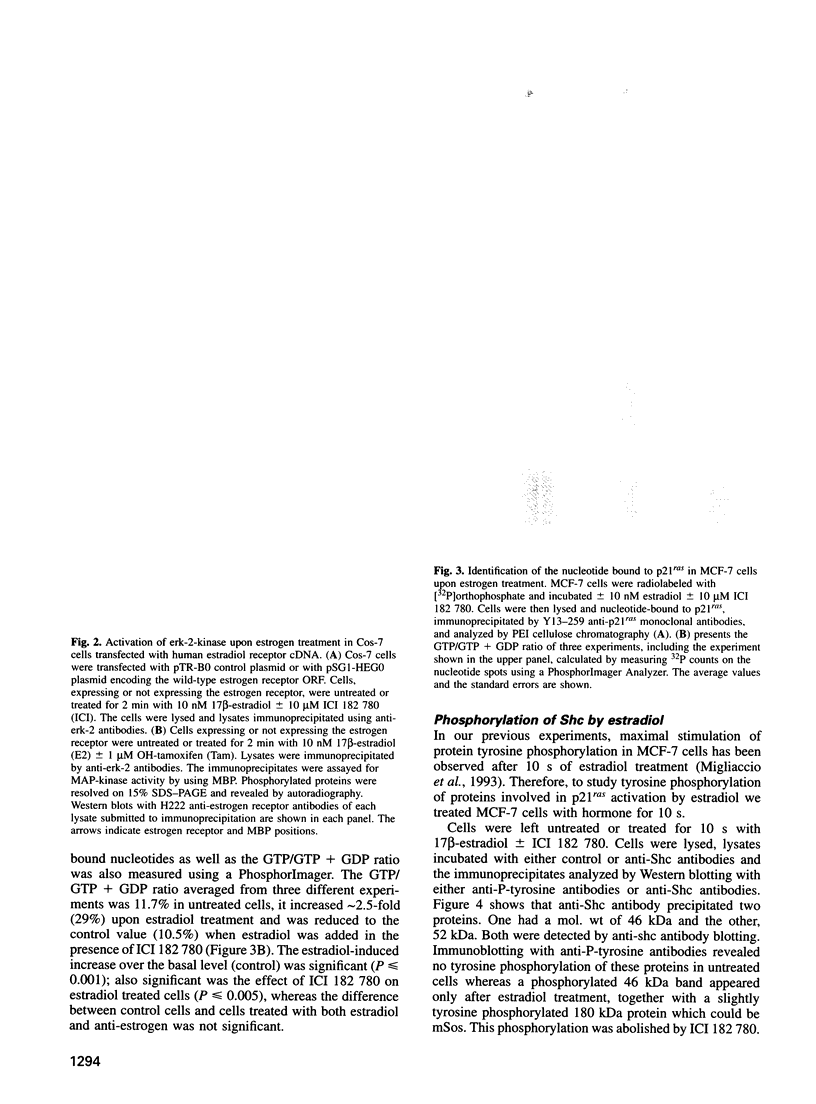
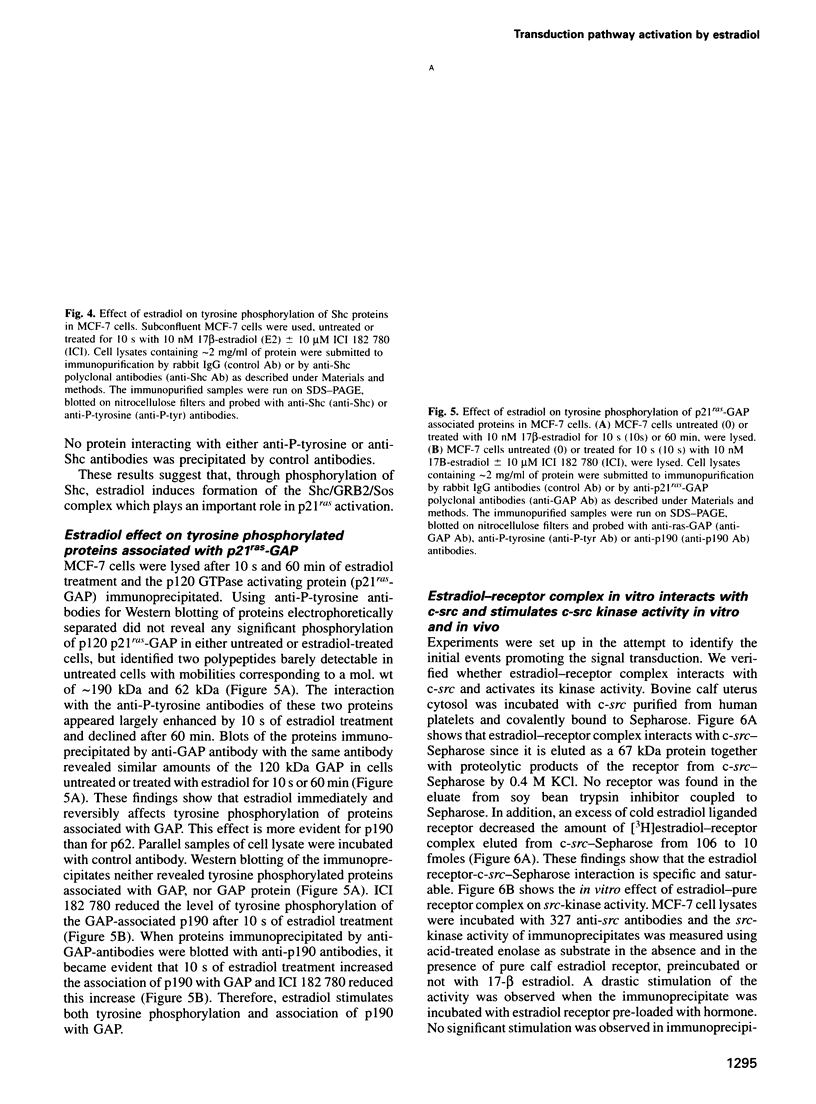
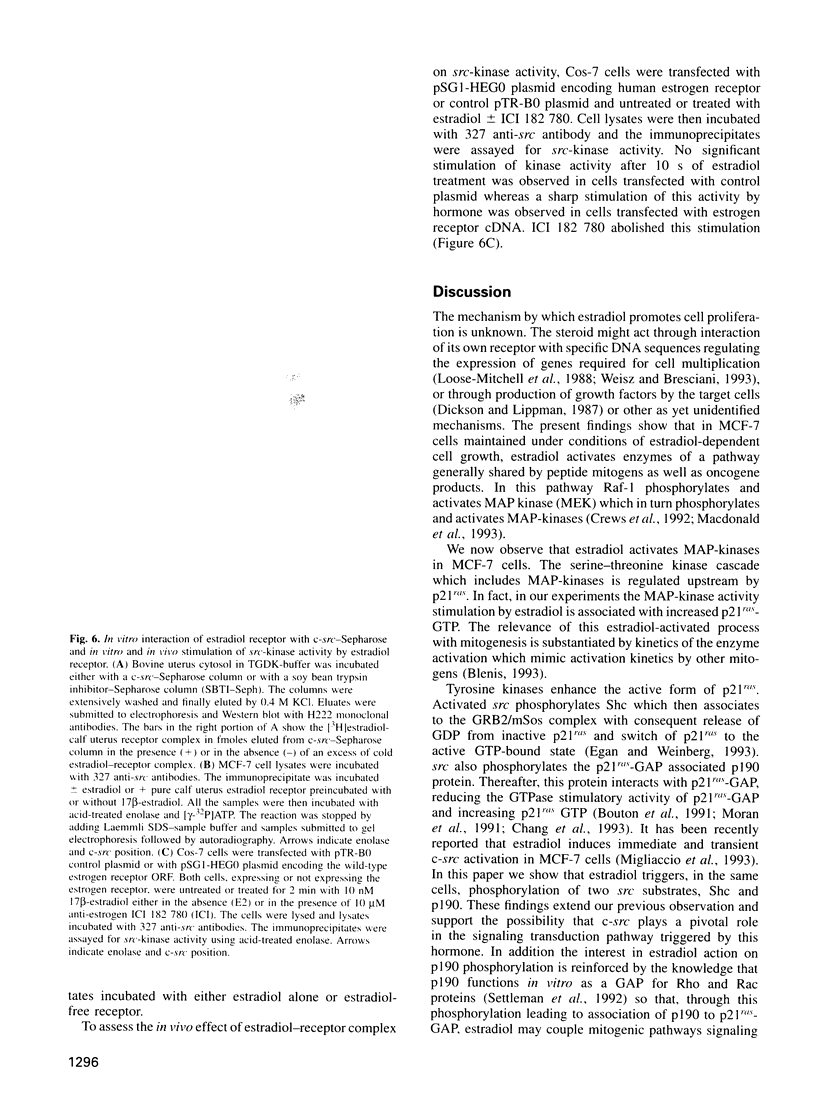
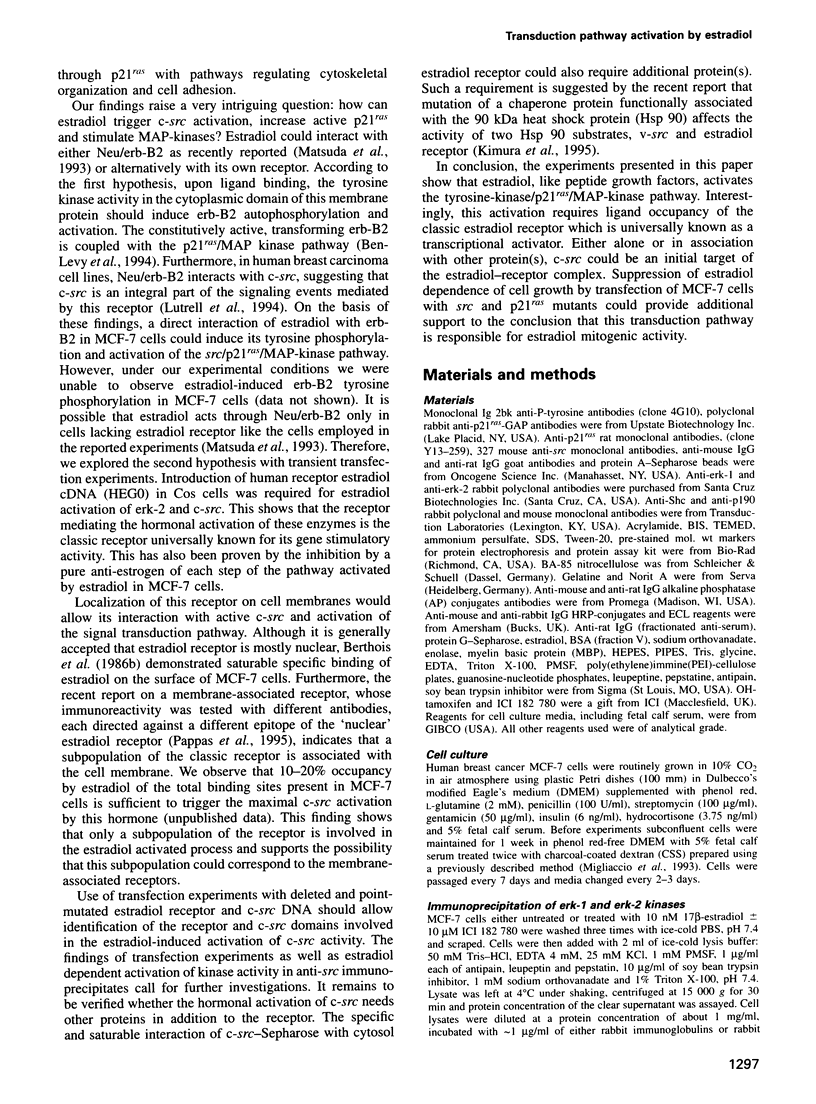
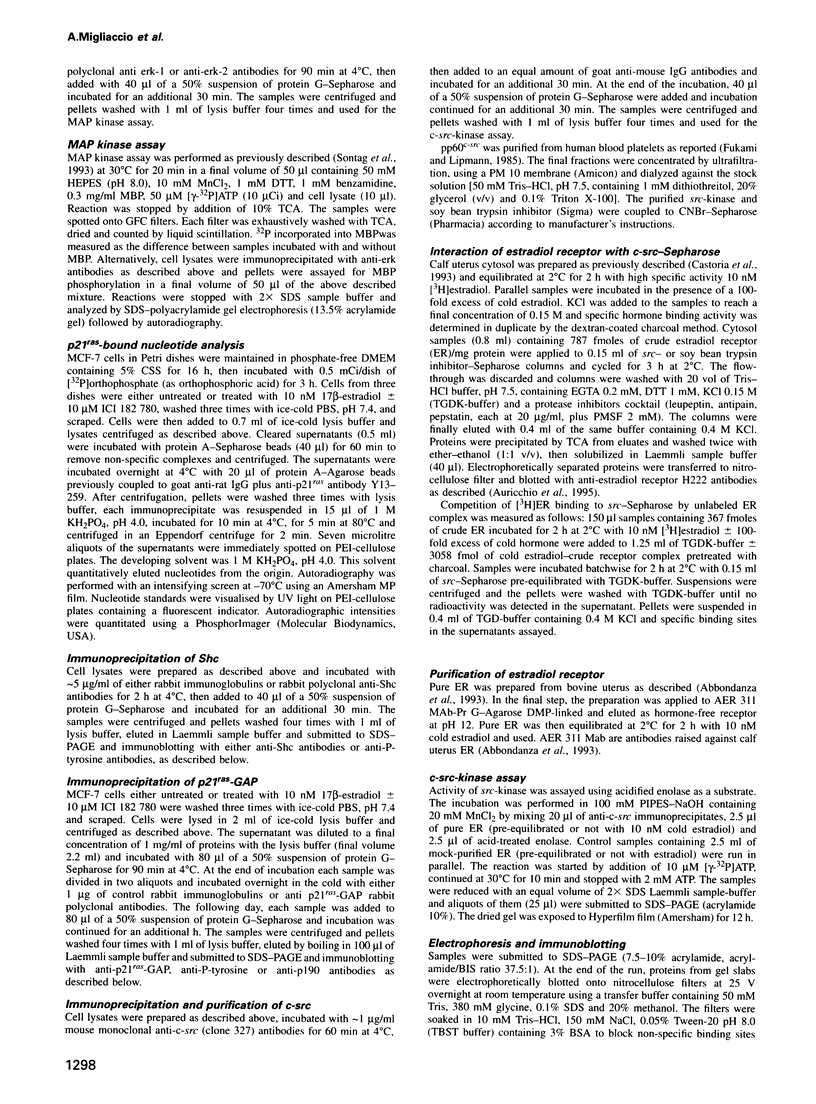
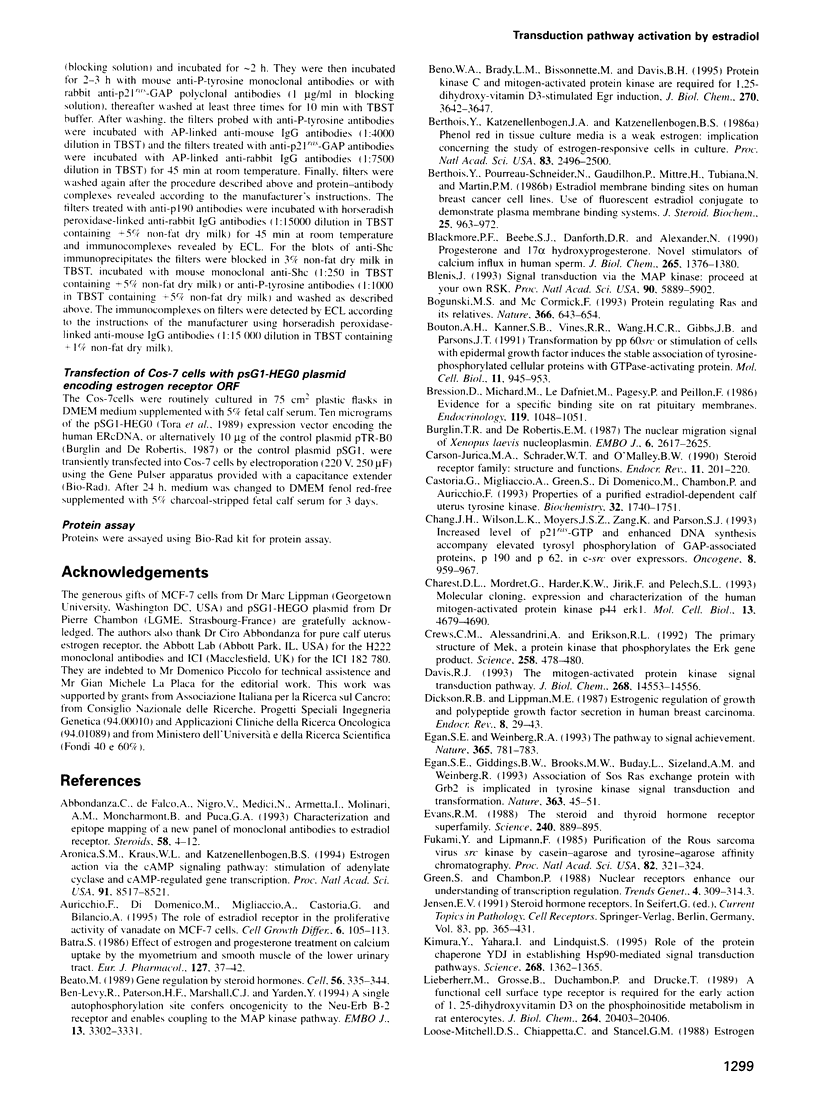
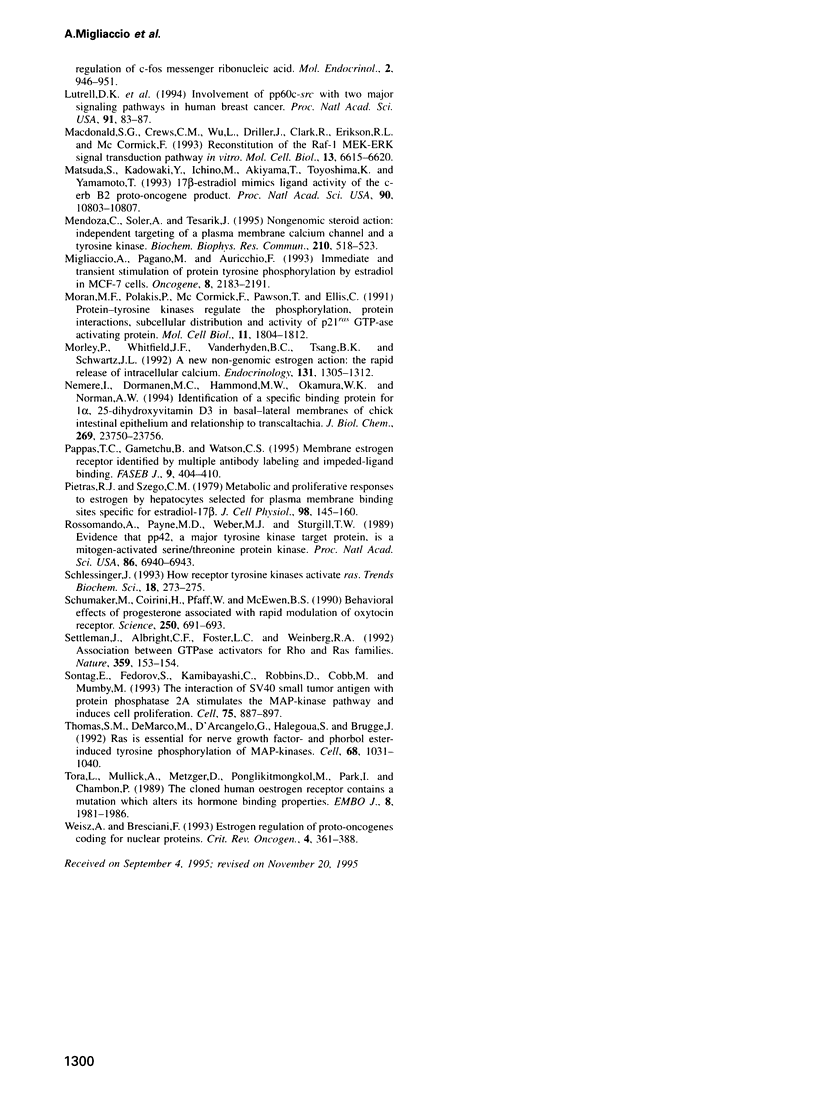
Images in this article
Selected References
These references are in PubMed. This may not be the complete list of references from this article.
- Abbondanza C., de Falco A., Nigro V., Medici N., Armetta I., Molinari A. M., Moncharmont B., Puca G. A. Characterization and epitope mapping of a new panel of monoclonal antibodies to estradiol receptor. Steroids. 1993 Jan;58(1):4–12. doi: 10.1016/0039-128x(93)90011-b. [DOI] [PubMed] [Google Scholar]
- Auricchio F., Di Domenico M., Migliaccio A., Castoria G., Bilancio A. The role of estradiol receptor in the proliferative activity of vanadate on MCF-7 cells. Cell Growth Differ. 1995 Feb;6(2):105–113. [PubMed] [Google Scholar]
- Batra S. Effect of estrogen and progesterone treatment on calcium uptake by the myometrium and smooth muscle of the lower urinary tract. Eur J Pharmacol. 1986 Aug 7;127(1-2):37–42. doi: 10.1016/0014-2999(86)90203-7. [DOI] [PubMed] [Google Scholar]
- Beato M. Gene regulation by steroid hormones. Cell. 1989 Feb 10;56(3):335–344. doi: 10.1016/0092-8674(89)90237-7. [DOI] [PubMed] [Google Scholar]
- Ben-Levy R., Paterson H. F., Marshall C. J., Yarden Y. A single autophosphorylation site confers oncogenicity to the Neu/ErbB-2 receptor and enables coupling to the MAP kinase pathway. EMBO J. 1994 Jul 15;13(14):3302–3311. doi: 10.1002/j.1460-2075.1994.tb06632.x. [DOI] [PMC free article] [PubMed] [Google Scholar]
- Beno D. W., Brady L. M., Bissonnette M., Davis B. H. Protein kinase C and mitogen-activated protein kinase are required for 1,25-dihydroxyvitamin D3-stimulated Egr induction. J Biol Chem. 1995 Feb 24;270(8):3642–3647. doi: 10.1074/jbc.270.8.3642. [DOI] [PubMed] [Google Scholar]
- Berthois Y., Katzenellenbogen J. A., Katzenellenbogen B. S. Phenol red in tissue culture media is a weak estrogen: implications concerning the study of estrogen-responsive cells in culture. Proc Natl Acad Sci U S A. 1986 Apr;83(8):2496–2500. doi: 10.1073/pnas.83.8.2496. [DOI] [PMC free article] [PubMed] [Google Scholar]
- Berthois Y., Pourreau-Schneider N., Gandilhon P., Mittre H., Tubiana N., Martin P. M. Estradiol membrane binding sites on human breast cancer cell lines. Use of a fluorescent estradiol conjugate to demonstrate plasma membrane binding systems. J Steroid Biochem. 1986 Dec;25(6):963–972. doi: 10.1016/0022-4731(86)90330-4. [DOI] [PubMed] [Google Scholar]
- Blackmore P. F., Beebe S. J., Danforth D. R., Alexander N. Progesterone and 17 alpha-hydroxyprogesterone. Novel stimulators of calcium influx in human sperm. J Biol Chem. 1990 Jan 25;265(3):1376–1380. [PubMed] [Google Scholar]
- Blenis J. Signal transduction via the MAP kinases: proceed at your own RSK. Proc Natl Acad Sci U S A. 1993 Jul 1;90(13):5889–5892. doi: 10.1073/pnas.90.13.5889. [DOI] [PMC free article] [PubMed] [Google Scholar]
- Bouton A. H., Kanner S. B., Vines R. R., Wang H. C., Gibbs J. B., Parsons J. T. Transformation by pp60src or stimulation of cells with epidermal growth factor induces the stable association of tyrosine-phosphorylated cellular proteins with GTPase-activating protein. Mol Cell Biol. 1991 Feb;11(2):945–953. doi: 10.1128/mcb.11.2.945. [DOI] [PMC free article] [PubMed] [Google Scholar]
- Bression D., Michard M., Le Dafniet M., Pagesy P., Peillon F. Evidence for a specific estradiol binding site on rat pituitary membranes. Endocrinology. 1986 Sep;119(3):1048–1051. doi: 10.1210/endo-119-3-1048. [DOI] [PubMed] [Google Scholar]
- Bürglin T. R., De Robertis E. M. The nuclear migration signal of Xenopus laevis nucleoplasmin. EMBO J. 1987 Sep;6(9):2617–2625. doi: 10.1002/j.1460-2075.1987.tb02552.x. [DOI] [PMC free article] [PubMed] [Google Scholar]
- Carson-Jurica M. A., Schrader W. T., O'Malley B. W. Steroid receptor family: structure and functions. Endocr Rev. 1990 May;11(2):201–220. doi: 10.1210/edrv-11-2-201. [DOI] [PubMed] [Google Scholar]
- Castoria G., Migliaccio A., Green S., Di Domenico M., Chambon P., Auricchio F. Properties of a purified estradiol-dependent calf uterus tyrosine kinase. Biochemistry. 1993 Feb 23;32(7):1740–1750. doi: 10.1021/bi00058a007. [DOI] [PubMed] [Google Scholar]
- Chang J. H., Wilson L. K., Moyers J. S., Zhang K., Parsons S. J. Increased levels of p21ras-GTP and enhanced DNA synthesis accompany elevated tyrosyl phosphorylation of GAP-associated proteins, p190 and p62, in c-src overexpressors. Oncogene. 1993 Apr;8(4):959–967. [PubMed] [Google Scholar]
- Charest D. L., Mordret G., Harder K. W., Jirik F., Pelech S. L. Molecular cloning, expression, and characterization of the human mitogen-activated protein kinase p44erk1. Mol Cell Biol. 1993 Aug;13(8):4679–4690. doi: 10.1128/mcb.13.8.4679. [DOI] [PMC free article] [PubMed] [Google Scholar]
- Crews C. M., Alessandrini A., Erikson R. L. The primary structure of MEK, a protein kinase that phosphorylates the ERK gene product. Science. 1992 Oct 16;258(5081):478–480. doi: 10.1126/science.1411546. [DOI] [PubMed] [Google Scholar]
- Davis R. J. The mitogen-activated protein kinase signal transduction pathway. J Biol Chem. 1993 Jul 15;268(20):14553–14556. [PubMed] [Google Scholar]
- Dickson R. B., Lippman M. E. Estrogenic regulation of growth and polypeptide growth factor secretion in human breast carcinoma. Endocr Rev. 1987 Feb;8(1):29–43. doi: 10.1210/edrv-8-1-29. [DOI] [PubMed] [Google Scholar]
- Egan S. E., Giddings B. W., Brooks M. W., Buday L., Sizeland A. M., Weinberg R. A. Association of Sos Ras exchange protein with Grb2 is implicated in tyrosine kinase signal transduction and transformation. Nature. 1993 May 6;363(6424):45–51. doi: 10.1038/363045a0. [DOI] [PubMed] [Google Scholar]
- Egan S. E., Weinberg R. A. The pathway to signal achievement. Nature. 1993 Oct 28;365(6449):781–783. doi: 10.1038/365781a0. [DOI] [PubMed] [Google Scholar]
- Evans R. M. The steroid and thyroid hormone receptor superfamily. Science. 1988 May 13;240(4854):889–895. doi: 10.1126/science.3283939. [DOI] [PMC free article] [PubMed] [Google Scholar]
- Fukami Y., Lipmann F. Purification of the Rous sarcoma virus src kinase by casein-agarose and tyrosine-agarose affinity chromatography. Proc Natl Acad Sci U S A. 1985 Jan;82(2):321–324. doi: 10.1073/pnas.82.2.321. [DOI] [PMC free article] [PubMed] [Google Scholar]
- Green S., Chambon P. Nuclear receptors enhance our understanding of transcription regulation. Trends Genet. 1988 Nov;4(11):309–314. doi: 10.1016/0168-9525(88)90108-4. [DOI] [PubMed] [Google Scholar]
- Kimura Y., Yahara I., Lindquist S. Role of the protein chaperone YDJ1 in establishing Hsp90-mediated signal transduction pathways. Science. 1995 Jun 2;268(5215):1362–1365. doi: 10.1126/science.7761857. [DOI] [PubMed] [Google Scholar]
- Lieberherr M., Grosse B., Duchambon P., Drüeke T. A functional cell surface type receptor is required for the early action of 1,25-dihydroxyvitamin D3 on the phosphoinositide metabolism in rat enterocytes. J Biol Chem. 1989 Dec 5;264(34):20403–20406. [PubMed] [Google Scholar]
- Luttrell D. K., Lee A., Lansing T. J., Crosby R. M., Jung K. D., Willard D., Luther M., Rodriguez M., Berman J., Gilmer T. M. Involvement of pp60c-src with two major signaling pathways in human breast cancer. Proc Natl Acad Sci U S A. 1994 Jan 4;91(1):83–87. doi: 10.1073/pnas.91.1.83. [DOI] [PMC free article] [PubMed] [Google Scholar]
- Macdonald S. G., Crews C. M., Wu L., Driller J., Clark R., Erikson R. L., McCormick F. Reconstitution of the Raf-1-MEK-ERK signal transduction pathway in vitro. Mol Cell Biol. 1993 Nov;13(11):6615–6620. doi: 10.1128/mcb.13.11.6615. [DOI] [PMC free article] [PubMed] [Google Scholar]
- Matsuda S., Kadowaki Y., Ichino M., Akiyama T., Toyoshima K., Yamamoto T. 17 beta-estradiol mimics ligand activity of the c-erbB2 protooncogene product. Proc Natl Acad Sci U S A. 1993 Nov 15;90(22):10803–10807. doi: 10.1073/pnas.90.22.10803. [DOI] [PMC free article] [PubMed] [Google Scholar]
- Mendoza C., Soler A., Tesarik J. Nongenomic steroid action: independent targeting of a plasma membrane calcium channel and a tyrosine kinase. Biochem Biophys Res Commun. 1995 May 16;210(2):518–523. doi: 10.1006/bbrc.1995.1690. [DOI] [PubMed] [Google Scholar]
- Migliaccio A., Pagano M., Auricchio F. Immediate and transient stimulation of protein tyrosine phosphorylation by estradiol in MCF-7 cells. Oncogene. 1993 Aug;8(8):2183–2191. [PubMed] [Google Scholar]
- Moran M. F., Polakis P., McCormick F., Pawson T., Ellis C. Protein-tyrosine kinases regulate the phosphorylation, protein interactions, subcellular distribution, and activity of p21ras GTPase-activating protein. Mol Cell Biol. 1991 Apr;11(4):1804–1812. doi: 10.1128/mcb.11.4.1804. [DOI] [PMC free article] [PubMed] [Google Scholar]
- Morley P., Whitfield J. F., Vanderhyden B. C., Tsang B. K., Schwartz J. L. A new, nongenomic estrogen action: the rapid release of intracellular calcium. Endocrinology. 1992 Sep;131(3):1305–1312. doi: 10.1210/endo.131.3.1505465. [DOI] [PubMed] [Google Scholar]
- Nemere I., Dormanen M. C., Hammond M. W., Okamura W. H., Norman A. W. Identification of a specific binding protein for 1 alpha,25-dihydroxyvitamin D3 in basal-lateral membranes of chick intestinal epithelium and relationship to transcaltachia. J Biol Chem. 1994 Sep 23;269(38):23750–23756. [PubMed] [Google Scholar]
- Pappas T. C., Gametchu B., Watson C. S. Membrane estrogen receptors identified by multiple antibody labeling and impeded-ligand binding. FASEB J. 1995 Mar;9(5):404–410. doi: 10.1096/fasebj.9.5.7896011. [DOI] [PubMed] [Google Scholar]
- Pietras R. J., Szego C. M. Metabolic and proliferative responses to estrogen by hepatocytes selected for plasma membrane binding-sites specific for estradiol-17beta. J Cell Physiol. 1979 Jan;98(1):145–159. doi: 10.1002/jcp.1040980116. [DOI] [PubMed] [Google Scholar]
- Rossomando A. J., Payne D. M., Weber M. J., Sturgill T. W. Evidence that pp42, a major tyrosine kinase target protein, is a mitogen-activated serine/threonine protein kinase. Proc Natl Acad Sci U S A. 1989 Sep;86(18):6940–6943. doi: 10.1073/pnas.86.18.6940. [DOI] [PMC free article] [PubMed] [Google Scholar]
- Schlessinger J. How receptor tyrosine kinases activate Ras. Trends Biochem Sci. 1993 Aug;18(8):273–275. doi: 10.1016/0968-0004(93)90031-h. [DOI] [PubMed] [Google Scholar]
- Schumacher M., Coirini H., Pfaff D. W., McEwen B. S. Behavioral effects of progesterone associated with rapid modulation of oxytocin receptors. Science. 1990 Nov 2;250(4981):691–694. doi: 10.1126/science.2173139. [DOI] [PubMed] [Google Scholar]
- Settleman J., Albright C. F., Foster L. C., Weinberg R. A. Association between GTPase activators for Rho and Ras families. Nature. 1992 Sep 10;359(6391):153–154. doi: 10.1038/359153a0. [DOI] [PubMed] [Google Scholar]
- Sontag E., Fedorov S., Kamibayashi C., Robbins D., Cobb M., Mumby M. The interaction of SV40 small tumor antigen with protein phosphatase 2A stimulates the map kinase pathway and induces cell proliferation. Cell. 1993 Dec 3;75(5):887–897. doi: 10.1016/0092-8674(93)90533-v. [DOI] [PubMed] [Google Scholar]
- Thomas S. M., DeMarco M., D'Arcangelo G., Halegoua S., Brugge J. S. Ras is essential for nerve growth factor- and phorbol ester-induced tyrosine phosphorylation of MAP kinases. Cell. 1992 Mar 20;68(6):1031–1040. doi: 10.1016/0092-8674(92)90075-n. [DOI] [PubMed] [Google Scholar]
- Tora L., Mullick A., Metzger D., Ponglikitmongkol M., Park I., Chambon P. The cloned human oestrogen receptor contains a mutation which alters its hormone binding properties. EMBO J. 1989 Jul;8(7):1981–1986. doi: 10.1002/j.1460-2075.1989.tb03604.x. [DOI] [PMC free article] [PubMed] [Google Scholar]
- Weisz A., Bresciani F. Estrogen regulation of proto-oncogenes coding for nuclear proteins. Crit Rev Oncog. 1993;4(4):361–388. [PubMed] [Google Scholar]



